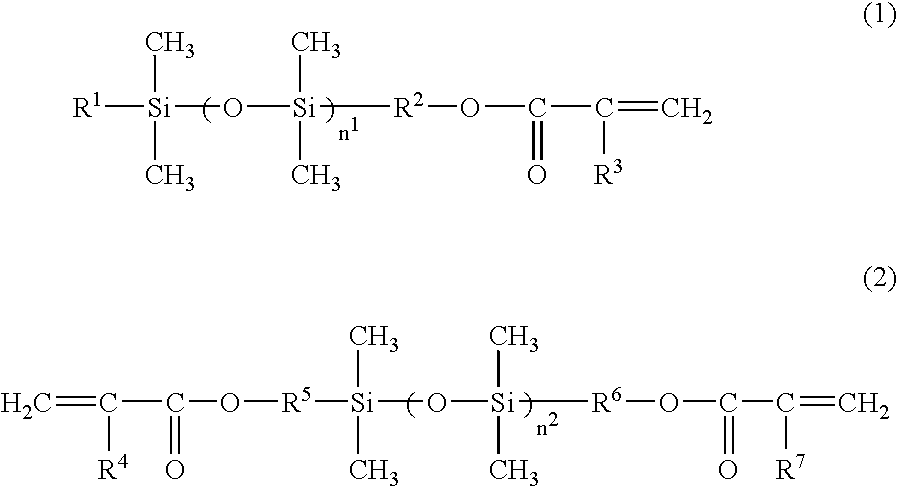Surface Treatment Agent
a surface treatment agent and surface treatment technology, applied in the direction of coatings, chemistry apparatus and processes, polish compositions, etc., can solve the problems of difficult to maintain the initial luster, formation of fine and frequent occurrence of fine cracks and flaws in the surface to be painted
- Summary
- Abstract
- Description
- Claims
- Application Information
AI Technical Summary
Benefits of technology
Problems solved by technology
Method used
Image
Examples
production example 1
[0090] 81.8 parts of n-butyl acetate were charged into a four-mouth flask equipped with a thermometer, reflux condenser, stirrer and dropping device followed by heating while stirring and holding at a temperature of 95° C. Next, a mixture comprised of 20 parts of Silaplane FM-0721 (see Note 1), 30 parts of γ-methacryloyloxypropyl trimethoxysilane, 10 parts of 2-hydroxyethyl methacrylate, 40 parts of i-butyl methacrylate and 4.2 parts of a photopolymerization initiator in the form of 2,2′-azobis(2,4-dimethylvaleronitrile) was dropped in over the course of 3 hours at a temperature of 95° C. Following completion of dropping, the mixture was aged for 2 hours at a temperature of 95° C. to obtain a solution of a siloxane polymer having a solid content concentration of 55%, number average molecular weight of 10,000 and containing hydrolysable alkoxysilyl groups and hydroxyl groups (A1). Furthermore, the molecular weight was measured using the HLC8120 GPC system available from Tosoh, a diff...
production example 2
[0093] 80 parts of methyl trimethoxysilane and 20 parts of dimethyl dimethoxysilane were added to a three-mouth flask followed by dropping in 10 parts of 0.05 N aqueous hydrochloric acid while stirring and hydrolyzing and condensing for 1 hour at 68° C. This was then heated to 120° C. to remove the by-product methanol followed by filtering to obtain an organopolysiloxane having a hydrolysable silyl group (B1).
production example 3
[0094] 85 parts of methyl trimethoxysilane and 15 parts of vinylmethyl dimethoxysilane were added to a three-mouth flask followed by dropping in 10 parts of 0.05 N aqueous hydrochloric acid while stirring and hydrolyzing and condensing for 2 hours at 68° C. This was then heated to 120° C. to remove the by-product methanol followed by filtering to obtain an organopolysiloxane having an alkoxy group (b1).
[0095] 250 parts of the organopolysiloxane (b1), 125 parts of a component having a linear dimethyl polysiloxane backbone in the form of a dimethyl polysiloxane having an Si—H group on both ends thereof (see Note 2) and 1.5 parts of CAT-PL-50T (trade name, Shin-Etsu Chemical, Pt-based catalyst) were added to a different three-mouth flask followed by hydrosilylation for 8 hours at 80° C. This was then treated under reduced pressure at 120° C. and 10 mmHg for 2 hours followed by filtering to obtain an organopolysiloxane having an organopolysiloxane having a three-dimensional structure a...
PUM
| Property | Measurement | Unit |
|---|---|---|
| water sliding angle | aaaaa | aaaaa |
| water contact angle | aaaaa | aaaaa |
| temperature | aaaaa | aaaaa |
Abstract
Description
Claims
Application Information
 Login to View More
Login to View More - R&D
- Intellectual Property
- Life Sciences
- Materials
- Tech Scout
- Unparalleled Data Quality
- Higher Quality Content
- 60% Fewer Hallucinations
Browse by: Latest US Patents, China's latest patents, Technical Efficacy Thesaurus, Application Domain, Technology Topic, Popular Technical Reports.
© 2025 PatSnap. All rights reserved.Legal|Privacy policy|Modern Slavery Act Transparency Statement|Sitemap|About US| Contact US: help@patsnap.com



